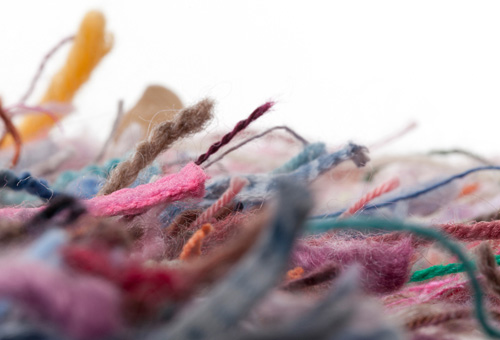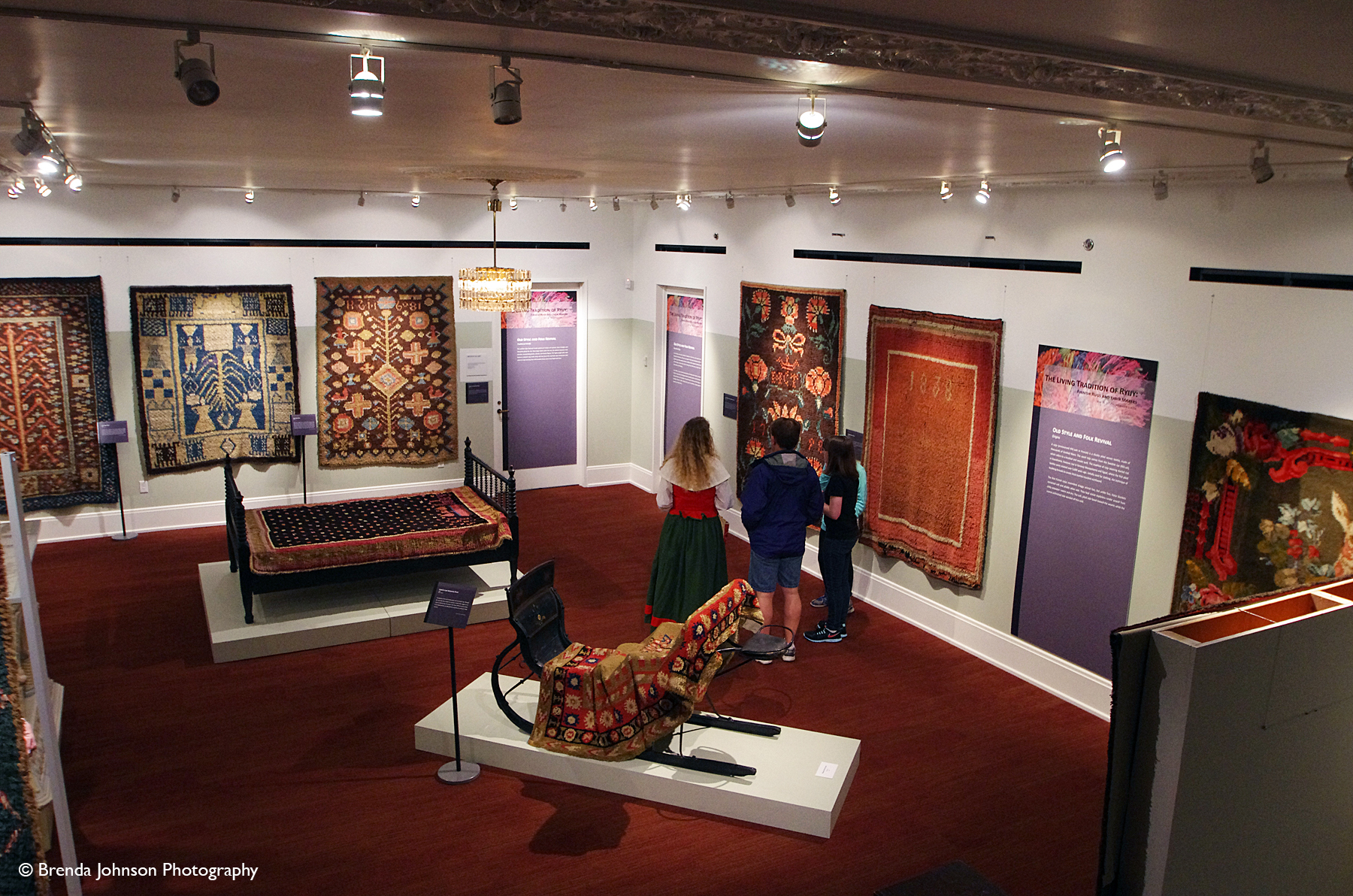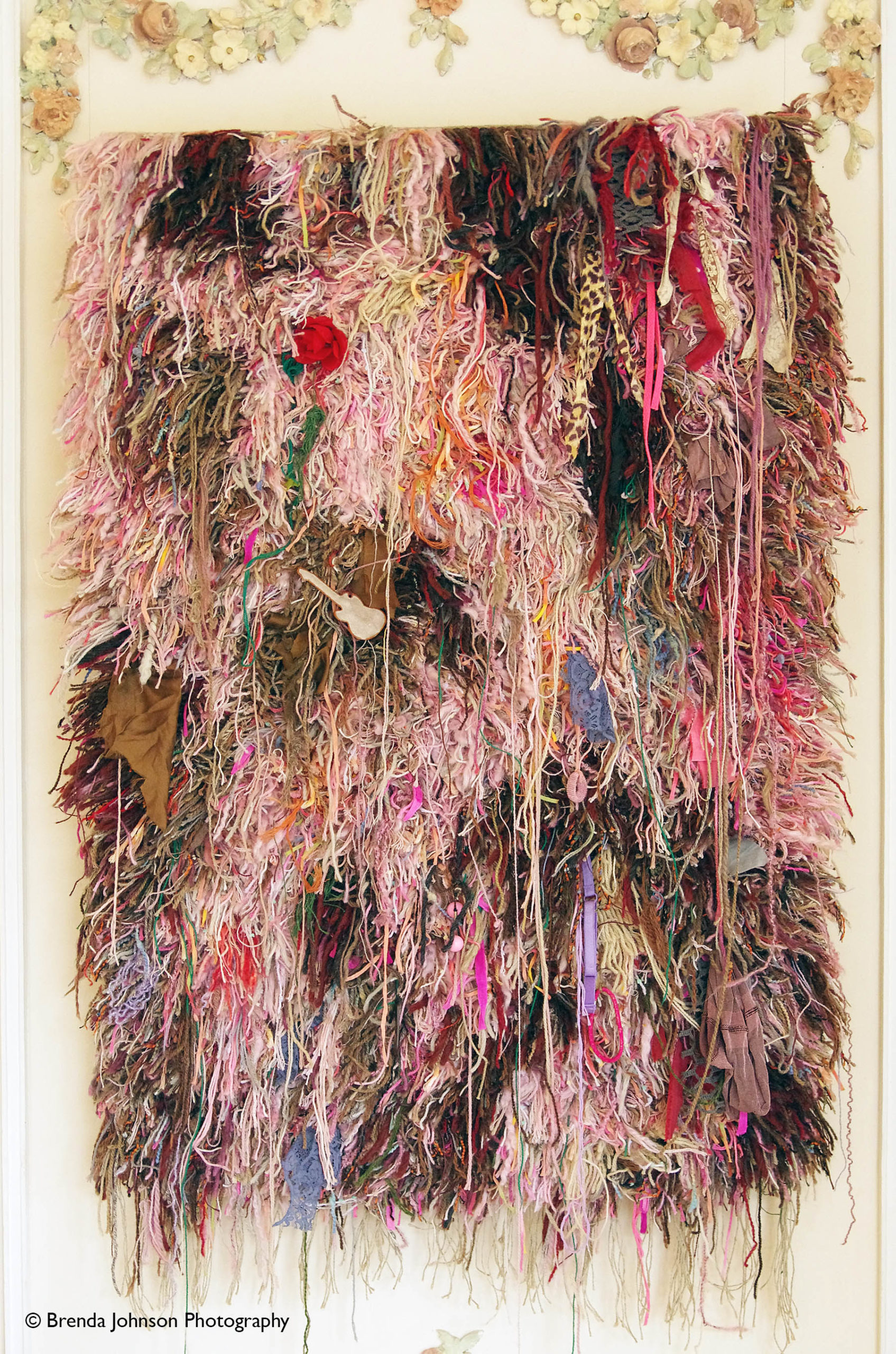The Warp and Weft of History
Handmade Finnish ryijy rugs offer an alternative to tech-driven cultural futures, showcasing the fertile vein of aesthetic possibilities that are, coincidentally, rooted in the myth and artistic traditions of the deep past.

The Future, we’re often told, is now. An arrogant yet convincing argument given the mind numbing sums of money currently spent on ‘new technologies.’ We now have equipment and devices specifically designed and marketed to make life easier by eliminating such supposedly burdensome relics as books, or fresh air. From smart phones to smart bombs we are blinded by the shining light of an insatiable zeal to innovate, consume, destroy, and innovate again in a cycle that seems truly endless, not to mention environmentally disastrous. It’s enough to make you curl up on a rug and weep.
And the American Swedish Institute (ASI) gives us the opportunity, metaphorically anyway, to do just that. With their current exhibition, The Living Tradition of Ryijy – Finnish Rugs and their Makers, they offer an alternative to the ‘future is now’ fantasy, showing us that the future is, coincidentally, rooted in the past. “The historical sense involves a perception, not only of the pastness of the past, but of its presence” T.S. Eliot wrote in Four Quartets. This exhibition offers a glimpse into that presence by way of a number of ryijy (pronounced RYE–ooh in Finnish) showcasing 300 years of development in this Finnish textile tradition. The show comes to ASI from the Savaria Museum in Budapest, Hungary, and is gathered from the private collection of the largest Ryijy collector in Finland, Dr. Tuomas Sopanen. A select 42 of his 390 rugs comprise the exhibition of work.

Although this exhibit offers a generous 300-year overview, the craft of Ryijy is much older, with obscure origins that lay in Mesopotamia and Egypt. Centuries ago, the Vikings took the Mediterranean knowledge of hand-weaving knotted textiles to the Nordic countries, where it continues to flourish as one of the longest lasting cultural traditions anywhere, now holding the status of a national art in Finland. With their thick, protective piles the rugs were originally used as covers for beds and sleighs in the fierce Finnish winters. These knotted rugs were especially valued at sea because they stayed warm while wet and wouldn’t harden after exposure to salt water. Over the centuries, their use and design changed with the shifting attitudes of the culture and the advent of industrially dyed fabrics, becoming esteemed wall hangings, floor coverings and eventually mass-produced commodities for export. It is fascinating to see how these objects, throughout their storied history, have retained the ability to absorb and reflect the beliefs and customs of the time in which they were made while holding on to the ancient thread that tethers them to the distant past. That history has a powerful grip coursing through the works in this exhibition — especially poignant now, in this America where continually projected futures increasingly displace memory of the warp and weft of our shared past.
Early ryijys, like the One-Tree Ryijy dated to approximately 1800, offers protection from this dangerous mindset by incorporating magic signs of shielding and good tidings into its design. A popular wedding motif, the One-Tree, or Tree of Life, would often serve as the literal foundation of the nuptial ceremony: covering the ground on which a couple stood to offer their vows, later to hang in their home, or to cover their wedding bed. The unknown artist responsible for this particular work has placed the mystic tree and its 18 bent limbs in the center of the rug. The tree is contained and sheltered within a series of borders, each containing its own markings and signs. The image is a steadfast reminder of how we long to achieve the growth the tree fosters within itself – the reach and root, the sturdiness and balance between high and low. How, from a tiny, bare seed of potential, the Self can grow into existence, centered and contained, meeting each season and holding its ground.
These images of the mutable states of natural transformation and maturity are beautifully expressed in another, more modern ryijy from 1968 titled Kupari (Copper) by Uhra Simberg-Ehrström. An abstract composition in a series of colors that radiate out from a center point, the rug depicts all the color variations of copper metal, from its red-hot molten state to its aged green patina. It is an apt image given copper’s known conductivity and ancient associations with the planet Venus, associations that carry us back to the Mediterranean roots of ryijy. In the ancient Greek world, the isle of Cyprus was believed to be the domain of the goddess Aphrodite (Venus); it is where large deposits of copper ore condensed and were mined. By depicting the various states of copper ore in a hand-made rug, Simberg-Ehrström calls us to consider the material and metaphoric nature of his practice, the phases and stages of creativity and the realms of influence that help shape it.

The Rosanuärinen (rose-colored) Ryijy from 2006, by Tenka Issaakainen, draws on this Venusian realm by tying together that historic tradition with the erotics of daily living. The rug is striking in its luscious use of various long, thick pink and brown yarns that both hold and conceal various objects – a small guitar, a stocking, a bra strap, a fabric rose – whose playful exuberance and serene composure bear witness to the tender human rites and passages that color all of human existence. Erotically connecting to a deep well of such personal memories, yet refusing us any single perspective, the Rosanuärinen Ryijy gives us a thorny prick of reality that precludes pure intimacy. It perfumes our knowledge with the lessons of yearning and desire within whose petalled folds the Self is secretly conceived.
The mighty river of folk tradition uncoils in the heart of the planet’s cultural imagination. Every now and again its currents pulse out and catch us, despite the many walls and levees built to stop it. Our modern syndrome – awash in feelings of anomie and alienation, of orphaning and rootlessness, the sense of being a commodity rather than a person, the loss of love, family and place – casts a long shadow over our lives. It’s both isolating and disrespectful when we pretend to wash away our past in a sea of technological information that promises us some “better” future engineered in a boardroom. With intimate care, people all over the world have preserved and cherished the relics of their ancestors. Some have even carried the lessons and traditions of those ancestors right into the present time. The living tradition of ryijy brings to light the mythopoetic images that connect us to a distant past, images concretized in the knots and pilling of woven fabric, the emblems of humanity’s accumulated experience.
Related exhibition information:
The Living Tradition of Ryijy –– Finnish Rugs and their Makers is on view at the American Swedish Institute in Minneapolis from May 31 to November 2, 2014.
Craig Olson in an artist and writer living in Minneapolis.